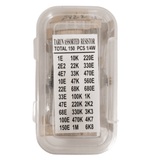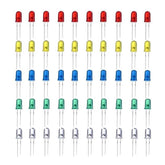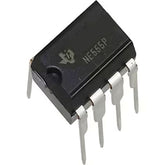How to avoid overheating of electronic components
Summary
Unlock the secrets to safeguarding your electronic devices with our latest blog on 'How to Avoid Overheating of Electronic Components.' Delve into the essential Introduction, discovering the Preventing strategies that could save your gadgets. Uncover the Causes of Overheating and learn about the Adverse Effects that follow. Stay ahead with our expert-approved Prevention and Mitigation Approaches. Don't miss the Conclusion that ties it all together. Your electronics deserve the best care – click now to ensure they stay cool and functional!
Preventing the Overheating of Electronic Components
The consistent and reliable performance of electronic devices is more critical now than ever before in history. From personal smartphones to industrial equipment, electronics have become deeply integrated into almost every facet of modern life. However, these invaluable devices are highly susceptible to failure and permanent damage if their temperature rises beyond safe operating limits.
Overheating poses a very significant threat to the longevity and normal function of electronic components. Therefore, every possible effort should be taken to avoid conditions that can cause excessive and dangerous heat buildup. With smart, diligent preventative measures, the risks of component degradation and catastrophic failure can be greatly minimized.

Causes of Overheating
Several key factors, if left unchecked, can contribute to the overheating of circuits, semiconductors, processors and other integral electronic parts. Being aware of these potential triggers is the first and most important step toward preventing hazardous thermal increases that can seriously impact performance and reliability.
Excessive Power Usage
Electronic components and circuits are designed to safely operate within a defined wattage range. Pushing electrical power usage outside of rated specifications will almost always lead to escalated heat production. Parts that are tasked beyond their design limits have to work harder, and all that additional effort generates extra waste heat that must be dissipated.
Printed circuit boards can easily overheat if subjected to current draws that exceed the rated capacity of on-board regulators or power supply units. Power spikes, improper wiring connections and short circuits can also suddenly overwhelm a part's heat tolerance by dumping immense amounts of power throughput into sensitive components.
For example, plugging too many high-draw appliances into a single power strip can push the current load past safe levels, risking overheating of the outlet and wiring. Graphics cards in computers can also readily overheat if the power supply unit does not provide enough wattage to support an intensive gaming application. Being mindful of the power demands and limits of electronic devices is key to avoiding thermal risks.
Inadequate Ventilation
Effective cooling of electronics relies heavily on the adequate flow of air over and through circuit assemblies. Restricted ventilation severely limits the ability for hot air surrounding components to properly dissipate. Electronic devices typically utilize fans and heat sinks to improve air circulation around the most heat-sensitive parts.
Blocked intake vents, clogged internal airways, and obstructed fans drastically reduce this essential convection cooling effect. Using electronic devices in tight, confined spaces also hinders ventilation, as surrounding air cannot circulate freely and heat is allowed to accumulate to dangerous levels. Proper airflow is absolutely critical to carrying away waste heat and preventing thermal failure.
For example, a crowded entertainment center or enclosed shelf space can restrict air movement around a hot-running receiver or game console. Over time, this will cause more heat soak and higher temperatures. Laptop computers are also prone to overheating when used on beds or sofas that block bottom vents. Checking for unobstructed ventilation pathways helps curtail risks.
Exposure to Direct Sunlight
The intense rays of the sun can significantly elevate the external temperature of electronic equipment through radiation heating. Direct absorption of solar energy by plastic or metal outer housing and cases raises surface temperatures rapidly. These high exterior temperatures then conduct inward to internal circuit boards and components.
Window-mounted electronics and automotive video displays are especially susceptible to sunlight-related overheating risks. Leaving devices in hot vehicles is also problematic due to greenhouse heating effects. Increased ambient temperatures due to sun exposure also reduce the cooling capacity of the surrounding air, further accelerating internal heat buildup. Keeping devices properly shaded from direct sunlight is an easy and effective method to avoid solar-related overheating damage.
Dust and Contaminant Accumulation
Heat sinks, cooling fans and exposed circuits all rely heavily on direct surface contact with air to transfer thermal energy away from sensitive components. Any buildup of particulate dust, pet hair or other contaminants acts as a suffocating insulating barrier that severely diminishes normal cooling capacity. Caked-on dirt prevents direct air contact needed for proper convection.
Dust particles become trapped between heatsink fins and other precision surfaces, degrading thermal performance. Fans overcome with debris do not move adequate air volume. Regular cleaning is absolutely essential to prevent gradual heat entrapment caused by dusty buildup on circuit boards and components. Electronics in workshops, garages and other potentially dirty locations require extra diligence to avoid dust-related overheating faults.

Adverse Effects of Overheating
Allowing electronics to exceed the safe thermal thresholds of components has major detrimental consequences. The elevated temperatures associated with overheating accelerate damage to parts and progressively degrade performance over time. Understanding these potential outcomes emphasizes the importance of preventative cooling measures.
Reduced Operational Lifespan
Excessive sustained heat stresses electronic parts far beyond their mechanical limits. The rising vibrations in overheated component materials weaken solder joints and eventually cause thermal expansion failures. These thermal stresses also stretch and distort the delicate geometries of printed circuit pathways over time, degrading reliability.
Combined with chemical breakdown of compounds, these structural factors heavily reduce the usable operational lifetime of overheated devices. The cumulative damage of heat-induced stresses takes an irreversible toll on overall longevity.
Impaired Performance and Speed
Electronic components and circuits operate best within specific optimal temperature ranges. As internal temperatures climb progressively higher beyond these ideal values, performance and speed will steadily decline. Excessive waste heat degrades processing capabilities for computer CPUs and integrated logic units.
Thermal noise also increasingly disrupts delicate electrical signals and voltage-controlled oscillation frequencies. Temperature-associated expansion effects alter the precision values of resistors and other components from their original design parameters. Without cooling intervention, functionality and capabilities will gradually suffer.
Risk of Catastrophic Failure
Extreme overheating, if left unchecked, poses the very real risk of catastrophic failure of electronic assemblies. Excessive sustained temperatures can irreversibly damage semiconductors or melt solder holding components in place. Thermal runaway issues can propagate as overstressed parts produce even more heat in a vicious cycle.
Structural solder connections throughout a circuit assembly may also fail as thermal expansion stresses exceed the physical limits of materials. In severe overheating emergencies, fires can even result from electrical shorts and arcing. While the severity of impacts ranges widely, extreme overheating always places equipment at risk of total functionality loss.
Prevention and Mitigation Approaches
However, diligent proactive actions can help avert many overheating hazards for electric components. Through intelligent design considerations and proper operating practices, dangerous thermal buildup can often be minimized.
Allow for Adequate Ventilation and Airflow
Maintaining sufficient airflow circulation for a device’s cooling requirements is a prime design objective. Equipment layouts at the board level should prevent obstruction of vent openings or choking of fans. For enclosures, exterior dust filters can improve airflow by reducing internal particulate accumulation over time.
Optimized spacing and separation between heat-producing components promotes air convection rather than trapping hot air against surfaces. Under-capacity cooling fans should be upgraded to higher CFM models that can provide adequate total air volume movement. Creating an unimpeded and efficient path for internal airflow is a key prevention strategy.
Strategic Component Placement
The physical placement of heat-generating electronic components has a huge impact on potential overheating severity. Parts should be arranged to avoid heat stacking or blocks. Burying hot-running ICs or regulators in the center of dense boards traps heat. Dispersing these evenly across the layout prevents hot spots. Horizontal separation from heat sinks, fans and air vents maintains convection efficiency. Breaking up concentrated heat generation prevents overload conditions in any localized area.
Use of Heat-Dissipating Materials
Specialized thermally conductive compounds can actively help transfer heat away from hot electronics parts to mitigate temperature rise. Applying thermally conductive paste or film between high-power components and their heat sinks improves surface contact and thermal transfer. These fill otherwise trapped air pockets that insulate. Silicone-based thermal oils or heat transfer liquids can also efficiently transmit waste heat if immersion or enclosure cooling methods are used.

Even phase change materials absorb significant thermal energy through latent heat processes as they melt or vaporize. Choosing thermally conductive outer casings promotes outward radiation rather than trapping heat internally. Effective use of these types of targeted materials directly aids heat rejection.
Position Electronics Away From Heat Sources
Avoid operating electronics near external heat emitters like radiators, ovens, burners or other heat-producing equipment. Ensure plenty of open clearance space around all exterior surfaces to allow efficient outward heat radiation. Using electronic devices in hot environments also adds to the cooling burden. Where possible, position installations to minimize solar heating and proximity to other electronics that exhaust waste heat. Reducing ambient temperatures eases demand on components and reserves cooling capacity.
Regular Maintenance and Cleaning
Establish routine cleaning protocols for electronics to prevent hazardous dust and debris buildup over time, both externally and internally when possible. Use compressed air or soft brushes to safely dislodge accumulated particulates from circuit boards, fans and heat sinks.

This regular cleaning is especially critical for electronics used in industrial or workshop environments with greater airborne debris. Portable consumer electronics also benefit from periodic cleaning of exterior vents and intake openings. Following diligent maintenance practices preserves optimal cooling effectiveness and airflow.
Active Cooling Systems
Beyond passive measures, specialized active cooling systems may be required to protect exceptionally heat-sensitive devices or electronics that operate in hot ambient conditions. Options like thermoelectric coolers, heat exchangers and liquid recirculation offer precise temperature control to counter heavy thermal loads. Dual/redundant fans provide backup protection in mission-critical devices. While advanced cooling adds complexity, it enables reliable operation in demanding high-temperature environments.
Monitor Usage and Warnings
Keep an eye on the temperature status displays and warning indicators implemented in many electronics. This could include readouts for component junction temperatures or CPU core temperatures. Internal thermal trip points and throttling demonstrates the device is working hard. Check that cooling vents are unobstructed if fans become much more audible. Be ready to reduce power or shut down if you see signs of heat building up within safe limits.
Emergency Shutdown
If rising temperatures trigger over-temperature safeguard features, immediate emergency shutdown may be required as a protective measure. Allowing devices to continue operation while in a nearly-critical overheat condition can quickly precipitate catastrophic failure.
Turn off overloaded equipment showing signs of excess heat like slowed performance, abnormal noise or sharp exterior warmth. Avoid restarting until the unit has adequately cooled down, and the root cause of overheating has been investigated and resolved. While inconvenient, emergency shutdowns are far preferable to replacing damaged electronics due to thermal failure.
Conclusion
In summary, preventing problematic overheating of electronic components should be a priority in any application. Allowing proper airflow, controlling dust contamination, regulating power usage and designing for efficient heat dissipation are proven methods to maintain safe, steady operating temperatures. With appropriate engineering considerations and vigilant operating practices, the risk of thermal damage can be greatly reduced.
Electronics are complex and delicate systems, and overheating remains one of the primary threats to their longevity and reliability. Taking sensible steps to keep components from getting excessively hot is effort well spent. Cool electronics last longer and perform better over time, so effective thermal management should never be overlooked.










